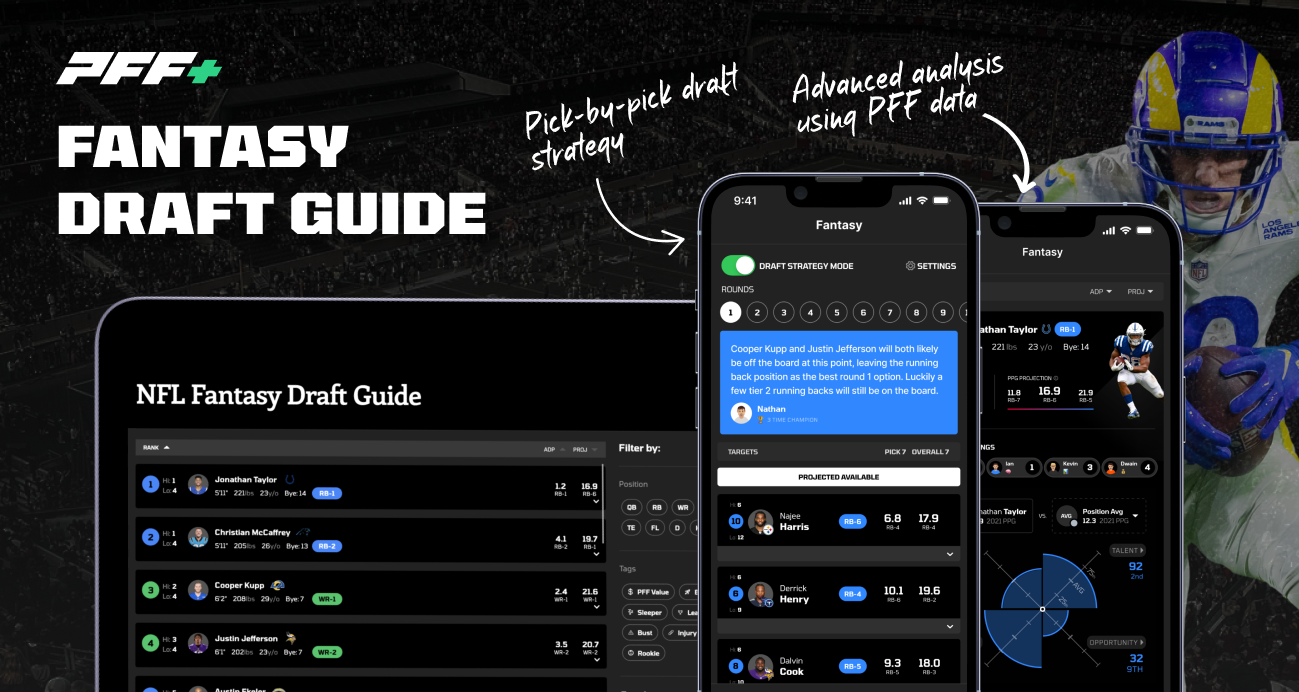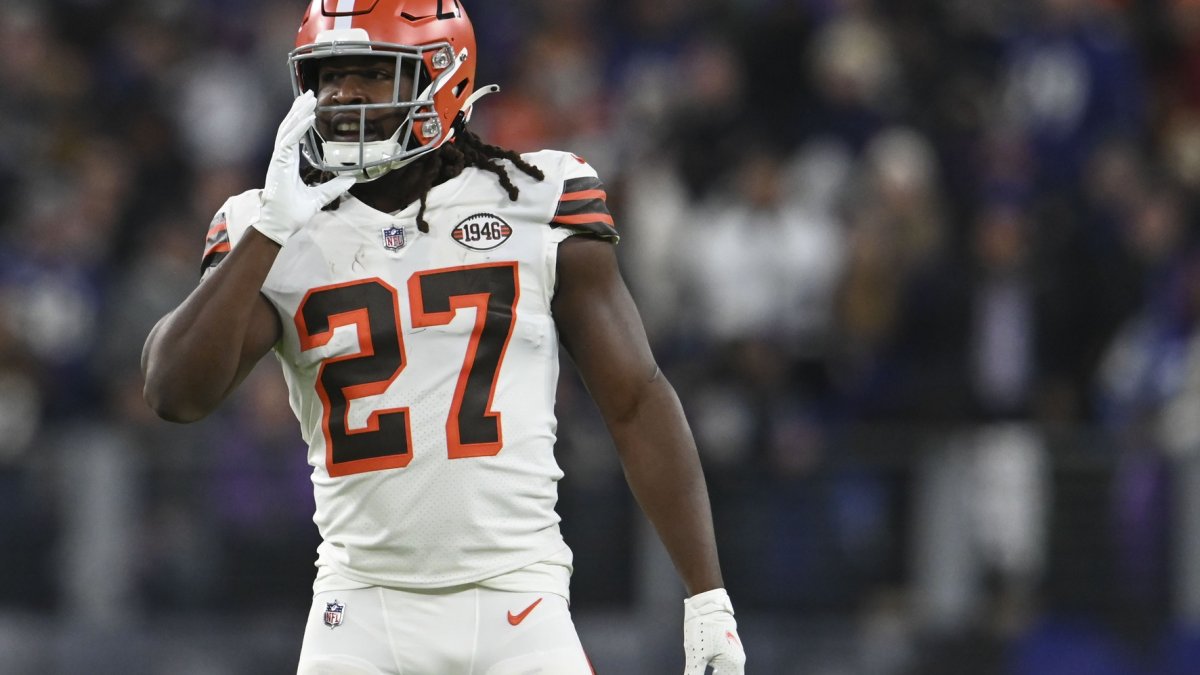Running backs touch the ball more than any other position and are responsible for seven of the top-10 highest-scoring fantasy seasons in football history regardless of position. The catch: Science does show that running backs are more prone to injury than other positions, meaning that sometimes these fantasy-friendly workhorse roles are suddenly thrust into the lap of an unsuspecting backup.
Of course, plenty of “backup” running backs remain sought-after fantasy assets thanks to a combination of 1.) standalone value in an offense that rotates multiple running backs, and 2.) upside in the event that their team’s starter goes down.
Today we’ll tier prospective handcuffs from all over the league in an effort to determine which backup running backs would be the most valuable with an injury. This is a bit of a subjective process: Different coaching staffs give different backups different-sized workloads depending on who is and isn’t healthy. Still, PFF’s fantasy projections present good starting points for both the backup’s own projected role, as well as the upside on the table should their team’s starter go down.

Tier 1: Solid standalone value with RB1 handcuff upside (4)
Cleveland Browns RB Kareem Hunt
Hunt got hurt in the game after Nick Chubb was injured in 2021, leading to a non-existent sample as the Browns’ lead back. Unfortunately, fluky things happened in 2020 when Chubb was banged up as well:
- Week 5: 20-72-0 rushing, 3-21-1 receiving, 70% snap rate
- Week 6: 13-40-0 rushing, 2-17-0 receiving, 53% snap rate (31 point loss)
- Week 7: 18-78-0 rushing, 3-26-1 receiving, 90% snap rate
- Week 8: 14-66-0 rushing, 2-7-0 receiving, 86% snap rate (Browns ran 47 total plays in horrific weather)
Meanwhile, Chubb averaged 17.5 carries and targets per game with Hunt in 2021, and just 17.6 without due to the presence of D’Ernest Johnson on passing downs. It seems far more unlikely that Johnson would maintain this involvement on fantasy-friendly pass downs vs. Hunt.
Hunt has worked as the RB23 and RB22 on a per-game basis over the past two seasons; he’s being priced well beneath his floor, while his ceiling is as the sort of upside RB1 that was regularly on display with the Chiefs in 2017 and 2018.
Dallas Cowboys RB Tony Pollard
Ezekiel Elliott has missed just one game since the Cowboys took Pollard in the fourth round of the 2019 NFL Draft. All the overqualified backup did was post 12-69-2 rushing and 6-63-0 receiving lines on an elite 90% snap rate on his way to finished as the week’s overall RB1.
The rising fourth-year talent has been anyone’s idea of one of the NFL’s most efficient running backs since entering the league in 2019:
- PFF rushing grade: 91.0 (tied for No. 4 among 94 running backs with 100 carries since 2019)
- Yards per carry: 5.1 (tied for No. 9)
- Yards after contact per carry: 3.9 (No. 4)
- Missed tackles forced per carry: 0.23 (tied for No. 6)
It doesn’t seem all that likely Pollard’s average of 11.7 combined carries and targets per game from 2021 increases, but his astonishing per-touch efficiency would make him a weekly upside RB1 inside of the NFL’s reigning top-ranked scoring offense should Zeke be forced out of action.
Denver Broncos RB Melvin Gordon
Gordon was the technical starter in all 16 of his games last season, but obviously fantasy football ADP disparity would lead you to believe it’s simply the Javonte Williams show these days. Don’t get me wrong: Williams deserves to go far higher in drafts after the Broncos waited until after the draft to re-sign Gordon to a meh one-year contract worth up to $5 million. Still, Gordon actually averaged more yards per carry and per reception than Williams while splitting snaps essentially right down the middle; we shouldn’t be too confident about what the new Denver coaching staff has planned.
The good news for both players involved is the reality that each would vault into upside RB1 territory should the other miss any time. Both Gordon and Williams have proven capable of handling three-down roles and each would boast even higher double-digit touchdown upside than they already do inside of an offense led by Russell Wilson. Gordon’s current price tag as the PPR RB37 seems far more indicative of his worst-case floor than his best-case scenario upside.
Green Bay Packers RB A.J. Dillon
Jones and Dillon posted the following numbers in 16 games together last season (including playoffs):
- Snaps: Jones (59%); Dillon (40%)
- Rush attempts: Jones (183); Dillon (169)
- Targets: Jones (74); Dillon (30)
- PPR points per game: Jones (16.1, RB12); Dillon (10.8, RB37)
- Expected PPR points per game: Jones (15.5, RB14); Dillon (10.3, RB42)
However, Dillon’s performance without Jones in Week 11 (11-53-0 rushing, 6-44-0 receiving, 75% snaps) demonstrated the reality that Green Bay trusts him on pass downs even in a game that featured them trailing by 7-plus points for large portions of the afternoon.
Don’t expect Dillon to fully overtake Jones, but an even more split committee is possible. Note that Dillon and Jones each had four regular-season games with 40-plus receiving yards last season; both are capable of working as legit three-down workhorses if needed.
Tier 2: Good standalone value with RB1-2 handcuff upside (5)
Buffalo Bills RB James Cook
It certainly doesn’t look like the Bills plan on fully featuring Cook. GM Brandon Beane said himself: “We see his (Cook) best skillset as a sub back. But, I think he can handle carries too if we give him some more carries”
The Bills’ second-round pick certainly seems capable of making some noise in full-PPR formats with a big role in the passing game.
Throw the ball to James Cook and good things happen pic.twitter.com/4EyqGOfEit
— Ian Hartitz (@Ihartitz) April 5, 2022
The only issue is whether or not the Bills would ever give Cook the sort of every-down role that Devin Singletary had down the stretch of 2021. The pass-game upside at hand would be more than enough keep Cook in the RB2 range should Singletary miss time, but it’s unclear if the Bills would view the 5-foot-11 and 199-pound back as a candidate for 15-plus carries on a weekly basis.



 © 2024 PFF - all rights reserved.
© 2024 PFF - all rights reserved.